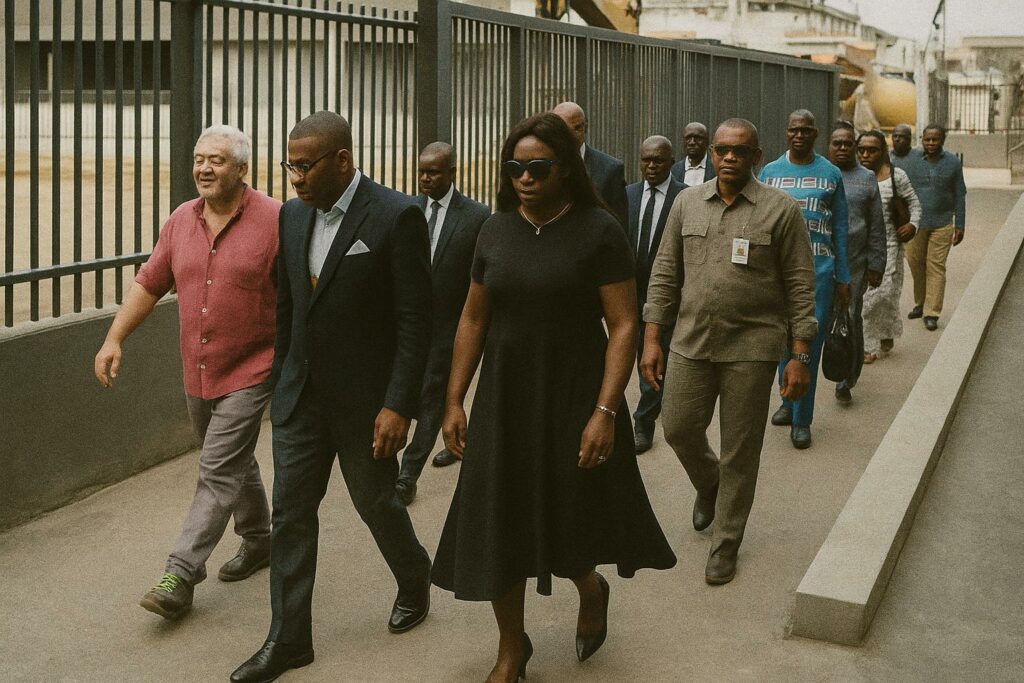Ministerial Inspection Highlights Rapid Construction Progress
During a mid-July tour of Pointe-Noire, Minister of Sanitation, Local Development and Road Maintenance Juste Désiré Mondélé offered a measured yet unmistakably positive verdict on the twin market projects that have dominated the city’s skyline since 2017. Standing before the concrete shells of the Central Market in Emery Patrice Lumumba District and the Market of Peace in Tié-Tié, he noted a 90 percent execution rate for the flagship site and praised the “unexpected celerity” at its counterpart, underscoring adherence to timelines and technical specifications (Agence Congolaise d’Information, 10 July 2024).
Infrastructure and Sanitation Synergy Underscored
Modern urban markets are only as useful as the sanitation networks that surround them, a point not lost on the minister or on municipal engineers. Expanded culverts, rehabilitated access roads and redesigned drainage grids aim to solve the recurrent flooding and refuse accumulation that previously plagued Pointe-Noire’s informal trading hubs. By integrating waste-handling bays, cold-storage units and regulated wastewater outlets into the architectural blueprint, the ministry seeks to align local practice with recommendations in the 2023 UN-Habitat guideline on resilient coastal cities.
Economic Ripple Effects on the Informal Sector
With roughly 70 percent of Pointe-Noire’s retail transactions occurring in the informal economy, the implications of relocating vendors from makeshift stalls at the Foire and OCH sites into purpose-built edifices are substantial. Analysts at the Congolese Observatory for Economic Diversification predict a ten-to-fifteen-percent rise in taxable municipal revenues once market fees and service charges are rationalised. Traders, many of them women who constitute the backbone of household income in coastal districts, anticipate steadier foot traffic and refrigeration capacity that extends product shelf life, thus reducing post-harvest losses currently estimated at 18 percent (World Bank Congo Economic Update, 2024).
Architectural Features Signal a Shift Toward Service-Oriented Commerce
Constructed by Italian firm Franco Villarecci, the Central Market’s twin R + 2 blocks offer 5 000 trading bays, integrated supermarkets, mezzanine restaurants and panoramic terraces designed to capture Atlantic breezes. Beyond catering to small merchants, the layout accommodates digital payment kiosks and fibre-optic cabling, foreshadowing a gradual migration towards cash-lite transactions. By contrast, the Market of Peace retains a more compact footprint yet mirrors the same ethos of modularity, allowing kiosks to convert swiftly from produce stalls to craft outlets in response to seasonal demand.
Timeline and Financing: Balancing Ambition with Fiscal Prudence
Initiated in May 2017, the projects navigated pandemic-related supply shocks without major cost overruns, a feat attributed to a diversified funding matrix combining state budget appropriations, a municipal infrastructure bond floated in 2019 and concessional credit from a consortium of regional banks. Ministry accountants place cumulative expenditure at 28 billion CFA francs, roughly aligned with figures flagged in the 2023 Court of Accounts report. Such fiscal discipline bolsters Brazzaville’s narrative of responsible investment, an asset as the government negotiates the next tranche of support under the IMF Extended Credit Facility.
Regional Urbanism Within a National Development Vision
Pointe-Noire’s market makeover dovetails with the National Development Plan 2022-2026, which assigns urban nodes along the RN1 corridor a catalytic role in post-hydrocarbon diversification. By prioritising public amenities that professionalise street commerce, the government seeks to weave informal actors into formal value chains, thereby broadening the tax base without coercive enforcement. Diplomats in Brazzaville read the initiative as a tangible complement to the President’s Africa Road Maintenance Alliance proposal, signalling that infrastructure policy remains firmly embedded in bilateral and multilateral dialogues.
Anticipated Socio-Environmental Impact and Outlook
Local civil-society organisations cautiously welcome the prospect of cleaner public spaces and reduced congestion, yet urge continued consultation to prevent rent escalation that could displace low-income vendors. The ministry, for its part, has committed to a phased relocation schedule and subsidised stall rents for the first twelve months, measures that mirror best practices cited in the African Development Bank’s Urban Markets Toolkit. In the minister’s own words, once the finishing touches are applied and peripheral roads decongested, “Ponténégrins will reclaim markets that match their city’s spirit of enterprise and hospitality.”
By most observable metrics—construction velocity, budget adherence and design quality—the Pointe-Noire market programme is on a trajectory to fulfil its promise. Come the official ribbon-cutting later this year, the concrete and steel structures may well serve as visible testimony to Congo’s steady, if understated, march toward inclusive urban modernity.

